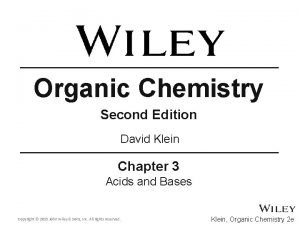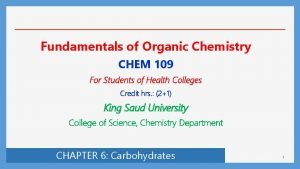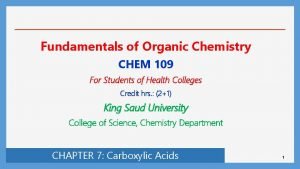Fundamentals of Organic Chemistry CHEM 109 For Students





























- Slides: 29

Fundamentals of Organic Chemistry CHEM 109 For Students of Health Colleges Credit hrs. : (2+1) King Saud University College of Science, Chemistry Department CHEM 109 CHAPTER 7. CARBOXYLIC ACIDS AND THEIR

Learning Objectives 2 At the end of this chapter, students will able to: Identify and name simple carboxylic acids. Recognize the properties (structure, physical and chemical properties) of carboxylic acid. Suggest preparation reactions from primary alcohols and from Grignard reagents and CO 2. Predict the product of the reduction of a carboxylic acid and give the reagents required to perform this reaction. Identify carboxylic acid derivatives as esters, amides, acid halides and acid anhydrides Predict the products that will be formed when a carboxylic acid derivative is

3 Structure of Carboxylic Acids o The functional group common to all carboxylic acids is the carboxyl group. The name is a contraction of the parts: the carbonyl and hydroxyl groups. o The general formula for a carboxylic acid can be written in expanded or abbreviated forms. o Depending on whether an R or an Ar. residue is attached to the carboxyl group; Carboxylic acids are classified as; § Aliphatic Carboxylic Acids. § Aromatic Carboxylic Acids. o Fatty acids. Long straight-chain carboxylic acids with even numbers of carbons, which were first isolated from

4 Nomenclature of Carboxylic Acids Common o The common names of carboxylic acids all end in -ic acid. Names o These names usually come from some Latin or Greek word that indicates the original source of the acid. o Common name, substituents are located with Greek letters, beginning with the –carbon atom. IUPAC o We replace the final e in the name of the corresponding alkane with the suffix System oic and add the word acid. Alkane- e + oic acid = Alkanoic acid o IUPAC system, the chain is numbered beginning with the carboxyl carbon atom, and substituents are located in the usual way.

5 Nomenclature of Carboxylic Acids

6 Nomenclature of Carboxylic Acids o The carboxyl group has priority over alcohol, aldehyde, or ketone functionality in naming. o The prefix oxo- is used to locate the carbonyl group of the aldehyde or ketone.

7 Nomenclature of Carboxylic Acids Ø Cycloalkane carboxylic acid When the carboxyl group is attached to a ring, the ending -carboxylic acid is added to the name of the parent cycloalkane. (i. e. Cycloalkanecarboxylic acid) Ø Aromatic acids are named by attaching the suffix -oic acid or -ic acid to an appropriate prefix derived from the aromatic hydrocarbon.

8 Nomenclature of Carboxylic Acids Ø Dicarboxylic acids (acids that contain two carboxyl groups) are known almost exclusively by their common names. Ø Aliphatic dicarboxylic acids are given the suffix -dioic acid in the IUPAC system. Ø The three benzenedicarboxylic acids are generally known by their common names. Common name: IUPAC name: Benzene 1, 2 dicarboxylic Benzene 1, 3 dicarboxylic Benzene 1, 4 dicarboxylic

Physical Properties of Acids 9 o Carboxylic acids are polar and they form hydrogen bonds with themselves or with other molecules. o Carboxylic acids form dimer, with the individual units held together by two hydrogen bonds between electron-rich oxygens and electron-poor hydrogens. Boiling Points Therefore, they have high boiling points for their molecular weights-higher even those of comparable alcohols. Solubility in water Hydrogen bonding also explains the water solubility of the lower molecular weight carboxylic acids. § § The first four aliphatic acids (formic through butyric) are completely miscible in water. Aromatic acids are insoluble in water.

Physical Properties of Acids 10 Structure Name Mol. Wt. b. p. C Solubility in H 2 O at 25 C HCOOH CH 3 CH 2 OH Formic acid Ethyl alcohol 46 46 100 78 Very soluble CH 3 COOH CH 3 CH 2 OH Acetic acid n-Propyl alcohol 60 60 118 97 Very soluble CH 3(CH 2)3 COOH CH 3(CH 2)4 CH 2 O H Valeric acid n-Hexyl alcohol 102 187 156 4. 0 g/100 g H 2 O 0. 6 g/100 g H 2 O Ph-COOH Ph-CH 2 OH Benzoic acid 3 -Phenylethanol 122 250 Insoluble

Acid Strength and Structure 11 o Carboxylic acids (RCOOH) dissociate in water, yielding a carboxylate anion (RCOO-) and hydronium ion. Why carboxylic acids are more acidic than alcohols? Ø In ethoxide ion, the negative charge is localized on a single oxygen atom. Ø In acetate ion, on the other hand, the negative charge can be delocalized through resonance.

Acid Strength and Structure 12 Effect of Structure on Acidity; the Inductive o Acidities. Effect can vary depending on what other groups are attached to the molecule. o Recall that electron-withdrawing groups (-I) enhance acidity, and electronreleasing groups (+I) reduce acidity. This effect relays charge through bonds, by displacing bonding electrons toward electronegative atoms, or away from electropositive atoms.

Acid Strength and Structure 13 Effect of Structure on Acidity; the Inductive o Formic. Effect acid is a substantially stronger acid than acetic acid. This suggests that the methyl group is more electron-releasing (hence aniondestabilizing and acidity-reducing) than hydrogen. o Example: acetic acid with those of mono-, di-, and trichloroacetic acids. Comparison of acid strengths of acetic Acid and chlorinated acetic acids

Acid Strength and Structure 14 Effect of Structure Inductive Effect on Acidity; the The more chlorines, the greater the effect and the greater the strength of the acid.

1) 15 Hydrolysis (Nitriles) of Cyanides Preparation of Carboxylic Acids o The reaction requires either acid or base. Ø In acid, the nitrogen atom of the cyanide is converted to an ammonium ion. Ø In base, the nitrogen atom is converted to ammonia and the organic product is the carboxylate salt, which must be neutralized in a separate step to give the acid. o Alkyl cyanides are generally made from the corresponding alkyl halide.

2) Reaction of Grignard Reagents with Carbon Dioxide (Carbonation of Grignard Reagent) 16 Preparation of Carboxylic Acids o Grignard reagents add to the carbonyl group of carbon dioxide to give acids, after protonation of the intermediate carboxylate salt with a mineral acid like o aqueous The acid HCl. obtained has one more carbon atom (the reaction provides a way to increase the length of a carbon chain). + Mg(OH)2 X

1) Reactions with Bases: Salt Formation 17 Reactions of Carboxylic Acids o Carboxylic acids, when treated with a strong base, form carboxylate salts. Na+ -OH o Examples.

2) Nucleophilic Substitution Reactions 19 Reactions of Carboxylic Acids

Carboxylic Acid Derivatives 190 o Carboxylic acid derivatives are compounds in which the hydroxyl part of the carboxyl group is replaced by various other groups. o All acid derivatives can be hydrolyzed to the corresponding carboxylic acid.

201 Acid Chloride Carboxylic Acid Derivatives o Acyl chlorides have the general formula RCOCl. o Acyl chlorides are more common and less expensive than bromides or iodides. o Nomenclature: Acyl chlorides, or acid chlorides, are named by replacing the -ic acid ending of the parent acid by -yl chloride. o Preparation: They can be prepared from acids by reaction with thionyl chloride or phosphorous pentachloride.

211 Acid Chloride o Reactions: They can react rapidly with most nucleophile. o Examples: Carboxylic Acid Derivatives

Esters Carboxylic Acid Derivatives 221 o Esters are derived from acids by replacing the –OH group by an –OR group and have the general formula R/COOR. o Nomenclature: § § They are named in a manner analogous to carboxylic acid salts. The R part of the –OR group is name first, followed by the name of the acid, with the –ic acid ending changed to –ate. o Preparation: When a carboxylic acid an alcohol are heated in the presence of an acid catalyst (HCl or H 2 SO 4), an equilibrium is established with the ester and water.

Carboxylic Acid Derivatives Esters 231 o Reactions § Saponification; esters are commonly hydrolyzed with base. Na+ -OH § Ammonia converts esters to amides.

Amide s Carboxylic Acid Derivatives 248 Ø Amides are the least reactive of the common carboxylic acid derivatives. Ø Primary amides have general formula RCONH 2. Ø Nomenclature: Amides are named by replacing the –oic acid ending of the acid name with the –amide ending, This will be either for the common or the IUPAC name.

Amide s Carboxylic Acid Derivatives 251 o Preparation: § They can be prepared by the reaction of ammonia with esters, with acyl halides, or with acid anhydrides. § Amides can also prepared by heating the ammonium salts of acids as shown in the following scheme. o Reactions § Amides react with nucleophiles and they can be hydrolyzed by water. § Amides can be reduced by lithium aluminums hydride to give amines.

31 Acid Anhydrides Carboxylic Acid Derivatives Ø Acid anhydrides have general formula RCOOCOR. Ø Nomenclature: The name of an anhydrides is obtained by naming the acid from which is derived and replacing the word acid with anhydride.

32 Acid Anhydrides Carboxylic Acid Derivatives Ø Preparation • Acid anhydrides are derived from acids by removing water from two carboxyl groups under heating and effect of suitable catalyst. • Anhydrides can also be prepared from acid chlorides and carboxylate salts. This method is used for preparing anhydrides derived from two different carboxylic acids (mixed anhydrides).

33 Acid Anhydrides Carboxylic Acid Derivatives Ø Reactions • Anhydrides undergo nucleophilic acyl substitution reactions (They are more reactive than esters, but less reactive than acyl halides).

33 Uses of Carboxylic Acids Ø Salicylic acid o It can be used to create acne medications. o Therefore, It is used frequently in cleansers, liquid foundations, moisturizers, anti-aging hydrating creams, eye gels, and sun screens. Ø Acetylsalicylic Acid in Aspirin o Acetic acid acts as the precursor for the formation of an ester of salicylic acid which is used for aspirin (Acetyl Salicylic acid) production. Ø Citric Acid o Citric acid has a sour taste and is often used to add flavor to sour candies (covered in a white powder). o Because citric acid is non-toxic and acidic, it is an ideal preservative. (it causes the p. H to drop to a point where it is difficult for bacteria to survive). Ø Industrial uses o Manufacturing of soaps and detergents (oleic acid, Palmitic acid and stearic acid).
 Chem 109
Chem 109 Functional groups ib chemistry
Functional groups ib chemistry Organic vs inorganic chemistry
Organic vs inorganic chemistry General formula of alkane
General formula of alkane Induction chemistry
Induction chemistry Founder of organic chemistry
Founder of organic chemistry Canola oil
Canola oil Ester organic chemistry
Ester organic chemistry Displayed formula
Displayed formula Transition state energy diagram
Transition state energy diagram Ee organic chemistry
Ee organic chemistry Ario organic chemistry
Ario organic chemistry Pericyclic
Pericyclic David klein organic chemistry
David klein organic chemistry Organic chemistry 2nd edition klein
Organic chemistry 2nd edition klein Ario practice problems
Ario practice problems Preference order of functional groups
Preference order of functional groups Objective lab report example
Objective lab report example Organic chemistry conversion chart
Organic chemistry conversion chart Grade 10 organic chemistry
Grade 10 organic chemistry Cyclo organic chemistry
Cyclo organic chemistry Organic vs inorganic compounds
Organic vs inorganic compounds Organic chemistry wade
Organic chemistry wade Why is ceramic wool heated in cracking
Why is ceramic wool heated in cracking Organic chemistry vs biochemistry
Organic chemistry vs biochemistry Organic chemistry myanmar
Organic chemistry myanmar Ch3co+ electrophile name
Ch3co+ electrophile name M+2 mass spec
M+2 mass spec Hono organic chemistry
Hono organic chemistry Leaving group ability
Leaving group ability



















































